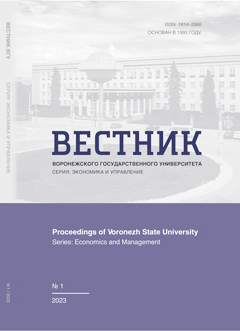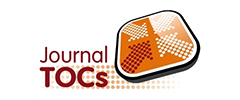
Руководство для авторов
Общие требования к представляемым материалам
Порядок представления материалов в редакцию
Технические требования к оформлению статей
Регистрация в системе Science Index и ORCID
Общие требования к представляемым материалам
Тематика публикаций
На страницах журнала публикуются результаты оригинальных исследований в области экономики и управления. К рассмотрению и публикации принимаются ранее не опубликованные статьи на русском языке и английском языке.
Объем материалов статьи
К рассмотрению принимаются материалы, содержащие результаты оригинальных исследований, оформленных в виде полных или обзорных статей. Объем рукописи не должен превышать 5000 слов, не включая библиографический список, таблицы, рисунки и подписи к ним. Минимальный объем рукописи составляет 2500 слов. Оригинальность текста основной части статьи должна быть не менее 70 % с учетом цитирований. Количество авторов в статье – не более 5.
Требования к структуре и содержанию разделов статьи
Статья должна быть написана хорошим русским или английским языком, аккуратно оформлена, тщательно отредактирована. Содержание оригинальной статьи должно соответствовать общепринятым нормам и должно быть четко структурировано.
УДК
Универсальная десятичная классификация (УДК) — международная система классификации информации, для систематизации произведений науки, литературы и искусства, периодической печати, различных видов документов и организации картотек.
JEL
Тематический классификатор Journal of Economic Literature (JEL), является всемирно признанной системой кодов для обозначения тематики публикаций по экономике. Ни одна современная статья в мировой периодике не выходит в свет без JEL-кодов.
Название
Должно быть лаконичным, точным и содержательным. Должно быть представлено на русском и английском языках. В названии желательно избежать использования знаков препинания, сокращений и аббревиатур.
Список авторов
Используя символ 1, 2 и т.д. указывается соответствие с названием организации (местом работы автора). Должен быть представлен на русском и английском языках. Отдельно указывается автор, уполномоченный вести переписку с редакцией.
Названия организаций (место работы авторов)
Перечисляются полные названия организаций (места работы авторов), индекс и полный адрес организаций (например: Воронежский государственный университет, Университетская пл., 1, 394018, Воронеж, Российская Федерация)
Данные должны быть представлены на русском и английском языках.
Аннотация (Abstract)
Аннотация представляется на английском и русском языках и сопровождается ключевыми словами. Она должна быть: информативной (без общих слов); структурированной (сжато повторять статью по схеме: предмет; цель исследования; метод или методология проведения исследования; результаты; обсуждение результатов; выводы); компактной (рекомендуемый объем аннотации 250-300 слов). В аннотации не используются: сложные грамматические конструкции; редкие сокращения и аббревиатуры; ссылки на источники; формулы и иллюстрации. В тексте аннотации не рекомендуется использовать формулы и специальные знаки.
Аннотация на английском языке должна отражать основное содержание статьи, описывать главные цели и способы проведения исследования, суммировать наиболее важные результаты исследования и их научное значение, следовать логике построения статьи, быть написана грамотным английским языком с использованием специальной англоязычной терминологии. Abstract включает следующие аспекты содержания статьи: предмет, тему, цель работы (purpose); метод или методологию проведения работы (methods and methodology); результаты работы, область применения результатов (results); выводы (conclusions). Для статей на русском языке аннотация на английском языке является единственным источником информации для иностранных ученых.
Ключевые слова (Keywords)
Максимум 5 слов или словосочетаний, соответствующие содержательной части статьи, так как используются для индексирования и онлайн поиска, должны быть представлены на русском и английском языках. Слова из названия использоваться не должны.
Введение (Introduction)
Раздел содержит обоснование актуальности решаемой задачи, постановку задачи с указанием ее особенностей, обзор основных подходов к решению, цель исследования. Раздел должен включать не менее 500 слов.
Введение начинается c обоснования актуальности тематики исследования и краткого описание современных трендов в рамках рассматриваемой проблематики. Далее проводится подробный анализ результатов предшествующих работ, который должен содержать обзор наиболее значимых и современных работ по рассматриваемой тематике и полученных в них результатов с обсуждением достоинств, недостатков, имеющихся пробелов или вопросов, уровень проработки которых, на Ваш взгляд, недостаточен и которые должна полностью или частично закрыть Ваша статья. Введение завершается формулировкой цели, задач и/или рабочей гипотезы исследования.
Методы исследования (Methods)
Раздел должен содержать четкое описание используемых для решения поставленной задачи методологии, объектов исследования, моделей, методов и алгоритмов, а также информацию об используемых пакетах компьютерных программ, информационной базе и других ресурсов, являющихся основой результатов, полученных авторами. В разделе могут присутствовать различные подразделы, названия которых определяется в зависимости от конкретной постановки задачи, например: «Описание предлагаемого метода или алгоритма…», «Предлагаемая математическая модель процесса…» «Методика исследования…, «Предлагаемый подход или принципы построения…» и т. п.
В разделе дается теоретическое описание и обоснование предлагаемых авторами решений (методов, методик, алгоритмов, моделей и т.п.). При составлении данного раздела авторы должны обратить внимание на представление своих результатов с точки зрения новизны (указав отличительные признаки), теоретической и практической значимости.
Раздел должен содержать описание исходных данных, условий и ограничений.
Результаты исследования (Results)
Раздел должен содержать эмпирические результаты, полученные в ходе решения задач проведенного исследования. Допускается сравнительный анализ полученных результатов как для альтернативных вариантов предлагаемого решения (при наличии), так и по отношению к известным решениям, полученным для аналогичных исходных данных. Для иллюстрации результатов рекомендуется использование графиков, таблиц, диаграмм и т.п. Результаты количественного анализа долны сопровождаться содержательной интерпретацией в контексте поставленной цели исследования.
Обсуждение результатов (Discussion)
Обязательный раздел, который предполагает анализ, сравнение собственных результатов с аналогичными в контексте существующего актуального международного знания. Содержание раздела должно наглядно показывать интеграцию авторских результатов в международное знание. Необходимы ссылки на зарубежную литературу, схожие исследования, формулировка научного вклада. В данном разделе следует также уделить внимание критическому анализу достоинств, недостатков и ограничений полученных результатов в плане их практического использования. Эта часть также может содержать обсуждение новизны работы в целом и ее вклад в уже существующие работы.
Заключение (Conclusion)
Раздел должен включать не менее 500 слов. Раздел содержит основные выводы по результатам исследования. Результаты работы описываются предельно точно и информативно. Предпочтение отдается новым результатам и результатам долгосрочного значения. Указываются их новизна и границы применимости. В разделе могут быть указаны направления дальнейших исследований по затронутой проблематике.
Источник финансирования (Source of Financing)
Необходимо указывать источник финансирования, как научной работы, так и процесса публикации статьи (фонд, коммерческая или государственная организация, частное лицо и др.).
Благодарности (Acknowledgement)
Все члены коллектива, не отвечающие критериям авторства, должны быть перечислены с их согласия.
Конфликт интересов (Conflict of Interest)
Указать наличие так называемого конфликта интересов, то есть усло-вий и фактов, способных повлиять на результаты исследования (например, финансирование от заинтересованных лиц и компаний, их участие в обсуж-дении результатов исследования, написании рукописи и т.д.). При отсутствии таковых использовать следующую формулировку: «Авторы декларируют отсутствие явных и потенциальных конфликтов интересов, связанных с публикацией настоящей статьи». Возможен раздел «ИНФОРМАЦИЯ О ВКЛАДЕ АВТОРОВ» (по желанию указывается, кто и что делал).
Библиографический список (References)
Библиографический список представляется авторами на русском и английском языках.
Ссылки на неопубликованные работы не допускаются!
Названия и сокращения
Недопустимо сокращать (или иным способом изменять) названия статей и названия журналов. Названия англоязычных журналов можно приводить в официальном сокращении. Для поиска правильного сокращенного названия журнала можно использовать CAS Source Index, библиотеку WorldCat или каталог Web of Science (ISI), каталог названий базы данных MedLine (NLM Catalog). Если официальное сокращение названия журнала найти не удалось — необходимо указывать его полное название.
Во всех случаях, когда у цитируемого материала есть цифровой идентификатор (Digital Object Identifier — DOI), его необходимо указывать в самом конце библиографической ссылки. Проверять наличие doi у источника следует на сайте http://search.crossref.org/ или https://www.citethisforme.com. Для получения DOI нужно ввести в поисковую строку название источника на английском языке. Последний сайт, помимо DOI, автоматически генерирует правильно оформленное библиографическое описание статьи на английском языке в стиле цитирования Harvard. Подавляющее большинство зарубежных журнальных статей с 2000 года и многие русскоязычные статьи (опубликованные после 2013 года) зарегистрированы в системе CrossRef и имеют уникальный DOI.
В библиографическом списке ссылки нумеруются по алфавиту. Библиографические ссылки в тексте статьи обозначаются цифрами в квадратных скобках.
Литература на русском языке оформляется по ГОСТ Р 7.0.5-2008.
- не менее 15 являются научными статьями
- не более 20% являются собственными работами
- не менее 30% являются зарубежными статьями в оригинале
- не менее 50% источников, в том числе зарубежные, опубликованы в последние пять лет
На английском языке библиографический список оформляется в стиле цитирования Harvard в версии Imperial College London.
Правила оформления библиографического списка на русском и английском языках представлены на сайте журнала в подразделе Технические требования к оформлению статей.
Информация об авторах
Раздел содержит ФИО авторов полностью, научная степень, научное звание, должность, название организации, полный адрес организации с индексом, телефон (включая код страны и региона), e-mail, идентификатор ORCID, который можно получить, зарегистрировавшись на сайте. Сведения должны быть представлены на русском и английском языках.
Порядок представления материалов в редакцию
Для рассмотрения рукописи авторам необходимо прислать на электронный адрес редакции журнала bulletin-em@econ.vsu.ru следующие материалы и документы:
- Текст статьи в формате MS Word 2007 и выше в формате *.docx.
- Текст статьи должен быть также представлен в формате *.pdf.
- Цветной скан Лицензионного соглашения о предоставлении права использования статьи в научном журнале “Вестник ВГУ. Серия: Экономика и управление” (распечатанного с сайта журнала и подписанного всеми авторами).
- Направление организации, заключение о возможности открытого опубликования, экспертное заключение комиссии внутреннего экспортного контроля.
- Рисунки должны быть хорошего качества и могут быть дополнительно представлены отдельными файлами в форматах *.png, *.jpg или *.tiff.
Технические требования к оформлению статей
Общие технические требования к текстам статей
Для упрощения оформления материалов представлен Шаблон для оформления статьи.
Подготовка статьи ведется с помощью текстового редактора MS Word 2007 и выше. В редакцию отправляется статья в формате *.docx (*.doc или *.rtf) и *.pdf (для правильного отображения обозначений и формул).
Параметры страницы рукописи: формат - A4; ориентация – портретная; верхнее поле – 2 см., правое поле – 1,5 см., нижнее поле – 2 см., левое поле – 3 см.
Набор текста
Основной шрифт документа – Times New Roman, основной размер шрифта – 14 pt. Межстрочный интервал – полуторный. В тексте не допускается использование цветных шрифтов, цветовых выделений. Для выделения терминов, определений рекомендуется использовать курсивный и полужирный шрифты. Не рекомендуется использовать подчеркивание.
Абзацный отступ устанавливается размером в 10 мм.
Заголовки разделов выравниваются по центру и не могут содержать переносов.
Статья может содержать заголовки трех уровней.
Заголовки первого уровня набираются прописными буквами полужирным шрифтом. Все разделы, кроме ВВЕДЕНИЯ, ЗАКЛЮЧЕНИЯ, БИБЛИОГРАФИЧЕСКОГО СПИСКА, могут нумероваться.
Заголовки второго уровня набираются полужирным шрифтом, номер двойной (содержит номер раздела и номер подраздела).
Заголовки третьего уровня набираются полужирным курсивом, номер тройной.
Заголовок отделяется от текста одной пустой строкой.
Допускаются ненумерованные заголовки, оформляются полужирным курсивом, по центру, от текста не отделяются.
Что нужно учесть при работе с текстом статьи
- Допускается только автоматическая расстановка переносов.
- Дефисы, минусы, тире. При наборе текста следует различать дефисы (-), короткое тире (–) и тире (—). Рекомендации по их использованию:
- Тире (без пробелов): высота 20–30 тыс. метров; это составляет 60–80 % всей массы груза;
- Тире (с пробелами): теорема Гаусса – Маркова;
- Дефис (без пробелов): два-три метра; Ойген фон Бём-Баверк; Санкт-Петербург; кредитно-денежная политика центрального банка;
- Правила наращения падежного окончания: 5-й (пятый, пятой), 5-я (пятая), 5-е (пятое, пятые), 5-м (пятым, пятом), 5-х (пятых), 5-го, 5-му, 30-ми.
В основную часть допускается помещать рисунки, таблицы и формулы.
Формулы
Все формулы, расположенные внутри текста, на отдельной строке, обозначения переменных, используемых в формулах при их описании в тексте, должны набираться в редакторе формул: MS Equation 3.0 или Math Type (стиль – по умолчанию, размер символов - 12 pt.) как отдельные объекты.
Ширина формулы не должна превышать 82,5 мм (ширина колонки печатного поля), включая номер формулы.
Переменные в формулах могут обозначаться латинскими и греческими буквами. Латинские буквы (строчные и прописные) набираются курсивным шрифтом (x, Y ). Греческие строчные — курсивным ( β ), греческие прописные — прямым шрифтом ( Ω ). Для обозначения векторов и матриц используется прямое полужирное начертание ( x, A ).
При изменении размера формулы использовать масштабирование запрещается!
Переносы в формулах. Место и обозначение переноса. Если формула при наборе не умещается в одной строке, то ее частично переносят на другую строку. В первую очередь перенос следует производить на знаках отношения между левой и правой частями формулы и т. д., во вторую — на отточии (...), знаках сложения и вычитания (+ , - , ±), и в третью — на знаке умножения в виде косого креста (×). На знаке деления перенос делать не рекомендуется.
Рисунки
Рисунки должны быть хорошего качества и дополнительно представлены отдельными файлами в форматах *.png, *.jpg или *.tif. При подготовке файлов в растровом формате желательно придерживаться следующих требований: для сканирования растровых рисунков использовать разрешение 600 dpi (точек на дюйм); для сканирования полутоновых рисунков и фотографий не менее 300 dpi (точек на дюйм).
Возможные размеры рисунка: 82,5 мм (ширина колонки), 170 мм (ширина печатного поля) или ≈ 128 мм (2/3 ширины печатного поля).
Размер шрифта в рисунках 11, 12 pt.
Подрисуночные подписи не должны быть включены в рисунок. Подписи к рисункам, таблицам, листингам программ и другому иллюстративному материалу, примечания и обозначения представляются на русском и английским языках.
Ссылки на рисунки в тексте оформляются следующим образом: рис. 1. Рисунок должен быть размещен ниже первой ссылки на него. В процессе верстки рисунок может быть перемещен на следующую страницу,
Ссылки на таблицы в тексте оформляются следующим образом: табл. 1.
Таблицы
Таблицы являются частью текста и не должны создаваться как графические объекты! Шрифт текста внутри таблицы 11-12 pt.
Подписи к таблицам должны быть на русском и английском языках.
Ссылки на таблицы в тексте оформляются следующим образом: табл. 1. Таблица должна быть размещена ниже первой ссылки на нее.
Библиографический список
В библиографический список рекомендуется включать не менее 20 источников. На все источники должны быть ссылки с указанием фамилий, например «в работе И. И Иванова [2] указано…». В качестве источников могут быть использованы только: статьи из печатных научных журналов (или электронных версий печатных научных журналов); монографии; опубликованные материалы научных конференций (очных, НЕ онлайн!); патенты. В библиографический список не включаются: учебники; статьи из любых ненаучных журналов; нормативные и законодательные акты; статистические сборники и архивы; электронные ресурсы (электронные журналы, онлайн-статьи, газетные и любые новостные ресурсы, доклады и разные исследования на сайтах, сайты учреждений и организаций); словари, энциклопедии, другие справочники; доклады, отчеты, записки, рапорты, протоколы.
Библиографический список русском языке оформляется по ГОСТ. Если у статей, на которые есть ссылки, есть DOI, то нужно их обязательно указать.
Для того, чтобы данные о публикациях русскоязычных авторов были правильно представлены в мировых базах данных реферативной и аналитической информации о научных исследованиях (SCOPUS, Web of Science, Google Scholar и др.), необходимо соблюдать ряд правил при представлении пристатейных библиографических списков на латинице в разделе «References».
References оформляется отдельным списком после библиографического.
В References источники указываются в том же порядке, в котором они указывались в библиографическом списке.
- Выходные данные. Библиографические описания следует составлять в стиле Harvard в версии Imperial College London (http://www.imperial.ac.uk/admin-services/library/learning-support/reference-management/harvard-style/your-reference-list/). Для описания даты выхода, тома и выпуска периодического издания и страниц, на которых опубликован источник ссылки, следует использовать сокращенный формат записи (примеры см. ниже).
- Пунктуация.
- В References не используются знаки предписанной по ГОСТ пунктуации «//», «/», «–», — их надлежит заменить на запятые и точки.
- При указании ФИО авторов инициалы следует помещать после фамилии. После Фамилии автора ставится запятая.
- Инициалы автора необходимо писать через пробел, отделяя их друг от друга точкой.
- Авторов следует отделять друг от друга запятой.
- После инициалов, в скобках указывается год издания, точки не ставятся.
- Название публикации следует отделять от остальной части ссылки точкой.
- Название издания (книги, научного журнала) следует писать курсивом.
- При указании даты публикации, места, издателя, иных выходных данных пунктуация должна соответствовать приведенным ниже примерам.
- Перевод и транслитерация. Если цитируемая Вами статья написанас на латинице (на английском, немецком, испанском, итальянском, финском, датском и других языках, использующих романский алфавит), ссылку на неё следует привести на оригинальном языке опубликования. Пример (статья в немецком журнале на немецком языке): Janzen, G., & Hawlik, M. (2005) Orientierung im Raum: Befunde zu Entscheidungspunkten. Zeitschrift fur Psychologie. 213 (4), 179–186. (In German)
- Если статья написана НЕ на латинице — на кириллице (в том числе, на русском), иероглифами и т.д., нужно привести ОФИЦИАЛЬНЫЙ ПЕРЕВОД или выполнить перевод на английский язык самостоятельно (парафраз) - для названий статей. Для книг необходимо в этом случае привести транслитерацию на латиницу и перевод названия на английский язык. В конце описания в скобках указать язык издания.
- Стандарт транслитерации. При транслитерации рекомендуется использовать стандарт BSI (British Standard Institute, UK). Для транслитерации текста в соответствии со стандартом BSI можно воспользоваться ссылкой.
- ФИО авторов, редакторов. Фамилии и инициалы всех авторов на латинице следует приводить в ссылке так, как они даны в оригинальной публикации. Если в оригинальной публикации уже были приведены на латинице ФИО авторов — в ссылке на статью следует указывать именно этот вариант (независимо от использованной системы транслитерации в первоисточнике). Если в официальных источниках (на сайте журнала, в базах данных, в том числе — в eLibrary) ФИО авторов на латинице не приведены — следует транслитерировать их самостоятельно по стандарту BSI.
- Название публикации. Если у цитируемой Вами работы существует официальный перевод на английский язык или англоязычный вариант названия (его следует искать на сайте журнала, в базах данных, в том числе — в eLibrary) — следует указать именно его. Если в официальных источниках название публикации на латинице не приведено — следует выполнить перевод на английский язык самостоятельно (парафраз).
- Название издания (журнала). Некоторые не англоязычные научные издания (журналы) имеют кроме названия на родном языке, официальное «параллельное» название на английском. Таким образом, для списка References в ссылке на статью из русскоязычного журнала следует указать либо транслитерированное название журнала, либо переводное. Переводное название журнала можно взять либо с официального сайта журнала (или использовать данные о правильном написании англоязычного названия из цитируемой статьи), либо проверить его наличие в базе данных, например в CAS Source Index, библиотеке WorldCat или каталоге Web of Science (ISI), каталоге названий базы данных MedLine (NLM Catalog). В случае, когда у журнала нет официального названия на английском языке, в References нужно приводить транслитерацию по системе BSI. Не следует самостоятельно переводить названия журналов.
- Место издания. Место издания в ссылках всегда следует указывать на английском языке и полностью — не в транслитерации и без сокращений. То есть Moscow, а не «Moskva» и не «M.:», Saint Petersburg, a не «Sankt Peterburg» и не «SPb».
- Название издательства/издателя. В отличие от места издания, название издательства для ссылок в References следует только транслитерировать (за исключением крайне редких случаев наличия у издателя параллельного официального англоязычного названия).
- Идентификатор языка. Если цитируемая Вами в References публикация исходно не англоязычная (если Вы делали перевод названия публикации и перевод/транслитерацию названия источника чтобы сделать ссылку в References) — в самом конце ссылки после указания диапазона страниц в круглых скобках следует указать идентификатор языка, на котором написан первоисточник. Для ссылок на русскоязычные источники, например, следует использовать фразу «(In Russian)».
Примеры библиографического описания
Статьи в журналах / Journal articles
Статья в журнале: печатный вариант / Journal article: Print
У русскоязычной статьи есть англоязычный вариант названия и у журнала есть англоязычный вариант названия.
Библиографический список
Васильев В.И. Местное самоуправление на пути централизации и сокращения выборности // Журнал российского права. 2015. № 9. С. 149–161.
Reference
Vasil'ev, V. I. (2015) Local Self Government on the Way to Centralization and Reduction of Electivity. Journal of Russian Law. (9), 149–161. (In Russian)
У статьи отсутствует англоязычный варианта названия и у журнала отсутствует англоязычный вариант названия.
Библиографический список
Красовский А.А. К реформе нашего гражданского процесса // Вестник гражданского права. 1914. № 1. С. 27–66.
Reference
Krasovskii, A. A. (1914) K reforme nashego grazhdanskogo protsessa [To the Reform of Russian Civil Process]. Vestnik grazhdanskogo prava. (1), 27–66. (In Russian)
Англоязычная статья в англоязычном журнале
Библиографический список
Norcross F. Criminal Law Reform // Journal of the American Institute of Criminal Law and Criminology. Vol. 1. N 3. P. 386–393.
Reference
Norcross, F. (1910) Criminal Law Reform. Journal of the American Institute of Criminal Law and Criminology. 1 (3), 386–393.
У журнала есть только выпуски (нет томов) / Journal has only issue number
Библиографический список
Васильев В.И. Местное самоуправление на пути централизации и сокращения выборности // Журнал российского права. 2015. № 9. С. 149–161.
Reference
Vasil'ev, V. I. (2015) Local Self Government on the Way to Centralization and Reduction of Electivity. Journal of Russian Law. (9), 149–161. (In Russian)
У статьи есть DOI / Journal article with DOI
Библиографический список
Lamond G. Analogical Reasoning in the Common Law // Oxford Journal of Legal Studies. 2014. Vol. 34. № 3. P. 567–588, doi:10.1093/ojls/gqu014.
Reference
Lamond, G. (2014) Analogical Reasoning in the Common Law. Oxford Journal of Legal Studies. 34 (3), 567–588. Available from: doi:10.1093/ojls/gqu014.
Публикации в электронных версиях журналов / Journal article: online
Библиографический список
Winkel L. Forms of Imposed Protection in Legal History, Especially in Roman Law // Erasmus Law Review. 2010. Vol. 3. № 2. Р. 155–162. Режим доступа: http://hdl.handle.net/1765/21274. Дата обращения: 20.01.2017.
Reference
Winkel, L. (2010) Forms of Imposed Protection in Legal History, Especially in Roman Law. Erasmus Law Review. 3 (2), 155–162. Available from: http://hdl.handle.net/1765/21274 [Accessed 20th January 2017].
Книги / Books
Книга: один или несколько авторов / Book has one or more authors
Библиографический список
Калашников Г.О. Слияние и поглощение компании по праву Европейского союза. М. : Международные отношения, 2007.
Reference
У русскоязычной монографии отсутствует англоязычный варианта названия
Kalashnikov, G. O. (2007) Sliyanie i pogloshchenie kompanii po pravu Evropeiskogo soyuza [Mergers and Acquisitions of Companies according to the European Union Law]. Moscow, Mezhdunarodnye otnosheniya publ. (In Russian)
Библиографический список
Ендовицкий Д.А., Соболева В.Е. Экономический анализ слияний/поглощений компаний. Москва, КноРус, 2008.
Reference
Endovitsky, D.A. & Soboleva, V.Е. (2008) [Financial Analysis of Mergers and Acquisitions]. Moscow, KnoRus Publ. (In Russian)
Англоязычная монография
Библиографический список
Gray C. The philosophy of law. New York : Routledge, 2012.
Reference
Gray, C. (2012) The philosophy of law. New York, Routledge.
Библиографический список
Merryman J., Perez Perdomo R. The civil law tradition. Stanford, Calif : Stanford Univ. Press, 2007.
Reference
Merryman, J. & Perez Perdomo, R. (2007) The civil law tradition. Stanford, Calif, Stanford Univ. Press.
Книги под общей редакцией (без авторов)
Библиографический список
Проблемы общей теории права и государства / под общ. ред. В.С. Нерсесянца. М. : Норма, 2004.
Reference
Nersesyants V. S. (ed.) (2004) Problemy obshchei teorii prava i gosudarstva [Problems of the General Theory of Law and the State]. Moscow, Norma. (In Russian)
У книги один или несколько редакторов
Библиографический список
The Constitution of the United States of America: Analysis and Interpretation / Killian J.H. Beck L.E., editors. Washington, D.C. : U.S. Government Printing Office, 1987.
Reference
Killian, J. H. & Beck, L. E. (eds.) (1987) The Constitution of the United States of America: Analysis and Interpretation. Washington, U.S. Government Printing Office.
Глава в книге / Сhapter in an edited book
Библиографический список
Randall L. Peace Treaties and the Formation of International Law // The Oxford handbook of the history of international law / Fassbender B., Peters A., Peter, S., editors. Oxford : Oxford University Press. P. 71–94.
Reference
Randall, L. (2012) Peace Treaties and the Formation of International Law. In: Fassbender, B., Peters, A. & Peter, S. (eds.) The Oxford handbook of the history of international law. Oxford, United Kindom, Oxford University Press, pp. 71–94.
Переводные книги / Book translated
Библиографический список
Фуллер Л. Мораль права / пер. с англ. Т. Даниловой. М. : ИРИСЭН, 2016.
Reference
Fuller, L. (1965) Moral' prava [The Morality of Law]. Translated from English by Danilova, T. (2016) Moscow, IRISEN. (In Russian)
Библиографический список
Эрлих О. Основоположение социологии права / пер. с нем. М.В. Антонова. СПб. : Университетский издательский консорциум, 2011.
Reference
Ehrlich, E. (1913) Osnovopolozhenie sotsiologii prava [Grundlegung der Sociologie des Rechts]. Translated from German by Antonov, M.V. (2011) Saint Petersburg, Universitetskii izdatel'skii konsortsium. (In Russian)
Материалы конференций / Conference proceeding
Библиографический список
Чиркин В.Е. Личные, частные и публичные интересы в современных конституциях // Интересы в праве. Жидковские чтения: материалы Всероссийской научной конференции. Москва, 25-26 марта 2016 г. / отв. ред. М.В. Немытина. М. : РУДН, 2017. С. 177–183.
Reference
Chirkin, V. E. (2017) Personal, Private and Public Interests in Modern Constitutions In: Nemytina, M. V. (ed.) Interests in Law. Zhidkov’s readings: Procedings of All-Russian Scientific Conference, 25–26 March 2016, Moscow, Russia. Moscow, RUDN, pp. 177–183. (In Russian)
Более детальную информацию по Harvard style и особенностям оформления ссылок на различные источники, можно получить на сайте.
Сведения об авторах
Сведения об авторах представляются на русском и английском языках, содержат следующие сведения: фамилия, имя, отчество автора; место работы и должность; ученая степень; ученое звание; идентификатор ученого ORCID, контактные данные (полный адрес организации места работы автора: город, страна, почтовый индекс учреждения); адрес электронной почты, телефон автора, индекс автора - ORCID.
Шаблоны
Регистрация в системе Science Index и ORCID
Science Index
Настоятельно рекомендуем авторам лично пройти регистрацию в Science Index (Российском индексе научного цитирования). Регистрация необходима для поиска публикаций, для доступа к полным текстам публикаций и для управления собственным списком публикаций.
Регистрация в виде заполнения анкеты занимает несколько минут. Обязательно надо поставить галочку в окошке "зарегистрировать меня в системе Science Index". Окончанием регистрации является получение Вами персонального SPIN-кода, который рекомендуется указывать в тексте статьи в разделе ДАННЫЕ ОБ АВТОРАХ.
ORCID
Настоятельно рекомендуем авторам лично пройти регистрацию в ORCID - это личный международный идентификатор научного автора ("Open Researcher and Contributor ID").
По просьбе авторов, получивших извещение о принятии статьи к публикации в журнале, но еще не имеющих кода ORCID, мы размещаем пошаговую инструкцию по регистрации.
ORCID разработан для того, чтобы статьи, книги и другие научные работы автора закреплялись в базах данных (Scopus, Web of Science и др.), индексирующих системах библиотек и т.д. за правильным автором (а, напр., не за однофамильцем). Он также нужен для предотвращения типичной проблемы, когда один и тот же автор ошибочно индексируется в базе данных под разными транслитерациями как два-три разных автора (т.е. напр.: Piatnitsky, Pyatnitzki и т.д.).
Зарегистрироваться в ORCID - в интересах всех авторов, имеющих кириллические фамилии и публикующихся в международных научных журналах.
ORCID - не "реферативная база данных" (как, напр., РИНЦ, Scopus и др.). Это независимая от этих баз данных система, нацеленная как раз на то, чтобы устранить проблемы присутствия и идентификации автора в этих базах данных. Идентификатор ORCID позволяет корректно проассоциировать Ваши работы с Вами.
Зайдите на сайт ORCID - там есть и англоязычный, и русскоязычный интерфейс (язык выбирается в правом верхнем углу). Зарегистрируйтесь, занесите русскоязычное и предпочитаемое латинизированное написание Вашего имени. Пришлите нам Ваш код ORCID для указания при статье.
Мы советуем Вам занести по крайней мере Ваше текущее место работы, т.е. институциональную аффилиацию. Если у Вас есть хотя бы одна публикация, уже отраженная в Scopus, мы также советуем Вам сразу же зарегистрировать Ваш ORCID ID в Scopus.
Для этого Вам нужно сделать следующее:
- Зайдите на страницу поиска авторов в Scopus
- Наберите Вашу фамилию и Ваше имя на латинице, нажмите кнопку поиска
- В полученном списке найдите себя, нажмите на Вашу фамилию, откроется Ваша "карточка"
- Справа нажмите на линк "Add to ORCID"
- Скопус автоматически направит Вас на страницу ORCID. Там, вместо регистрации заново, нажмите на "Sign in" ("Already have an ORCID ID? Sign In").
- Вводите Ваши логин и пароль к ORCID, и нажимаете "Authorize"
- Далее будет пара шагов по инструкции
Теперь в базе данных Скопус будет привязка Вас как автора к Вашему личному ORCID ID. Впредь, подавая статьи в любой индексируемый научный журнал, включайте в информацию об авторе Ваш ORCID ID и просите указывать его в авторских данных при статье.
Полезные инструменты и ссылки
- DRAW IO — облачный сервис для создания рисунков, блок-схем, графиков, таблиц и т.д.
- ORCID цифровой ключ к истории Ваших публикаций (есть русифицирорванный интерфейс) можно получить, зарегистрировавшись на сайте
- ГОСТ 7.1-2003
- ГОСТ Р 7.0.5-2008 Библиографическая ссылка
- Проверить наличие DOI у источника можно здесь или здесь
- Mendeley — социальная сеть ученых и программа для управления библиографической информацией
- Международный Комитет по публикационной этике (COPE)
- Scopus — база данных научного цитирования (доступ по подписке)
- Publons — позволяет любому зарегистрированному исследователю независимо подтвердить свою деятельность в качестве рецензента и редактора для любого из мировых журналов (не нарушая анонимность рецензирования).
- Транслитерация — сайт для автоматизированной транслитерации текстов
- Академия АНРИ — методические материалы, рекомендации и ссылки на полезные ресурчы для авторов и редакторов научных журналов
- УДК
- Расшифровка формул УДК
Заявление о конфиденциальности
Имена и адреса электронной почты, введенные на сайте этого журнала, будут использованы исключительно для целей, обозначенных этим журналом, и не будут использованы для каких-либо других целей или предоставлены другим лицам и организациям.






















